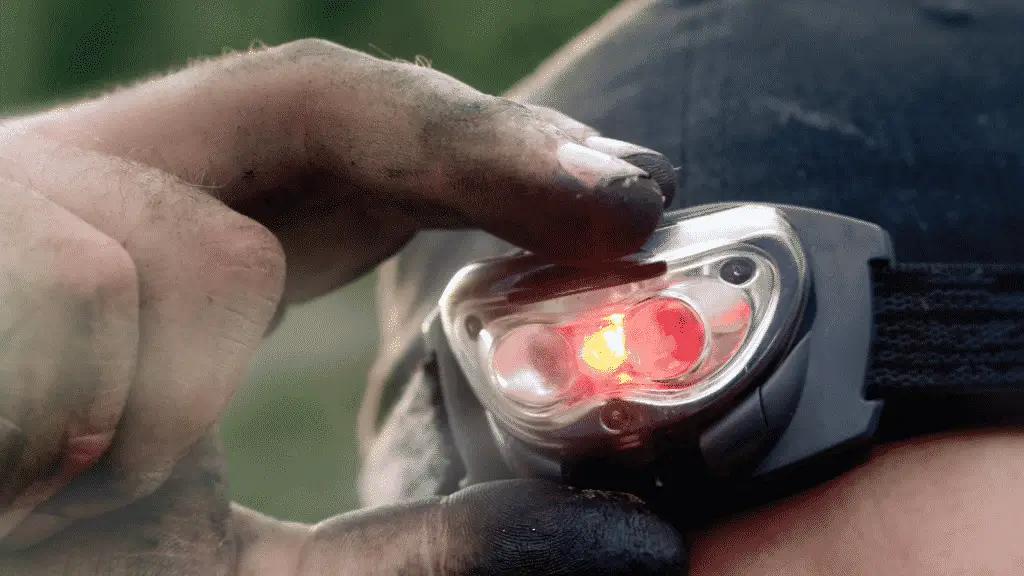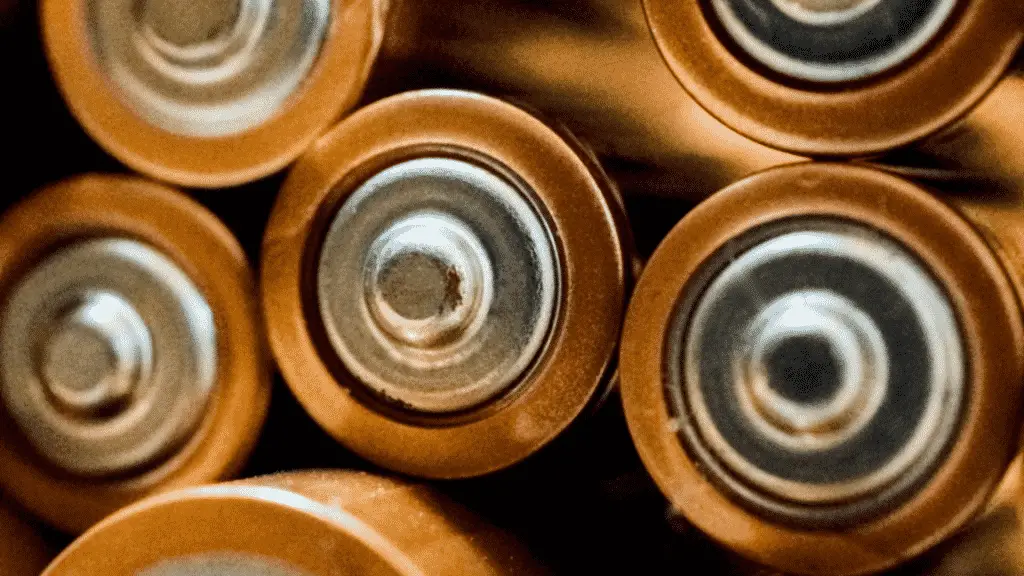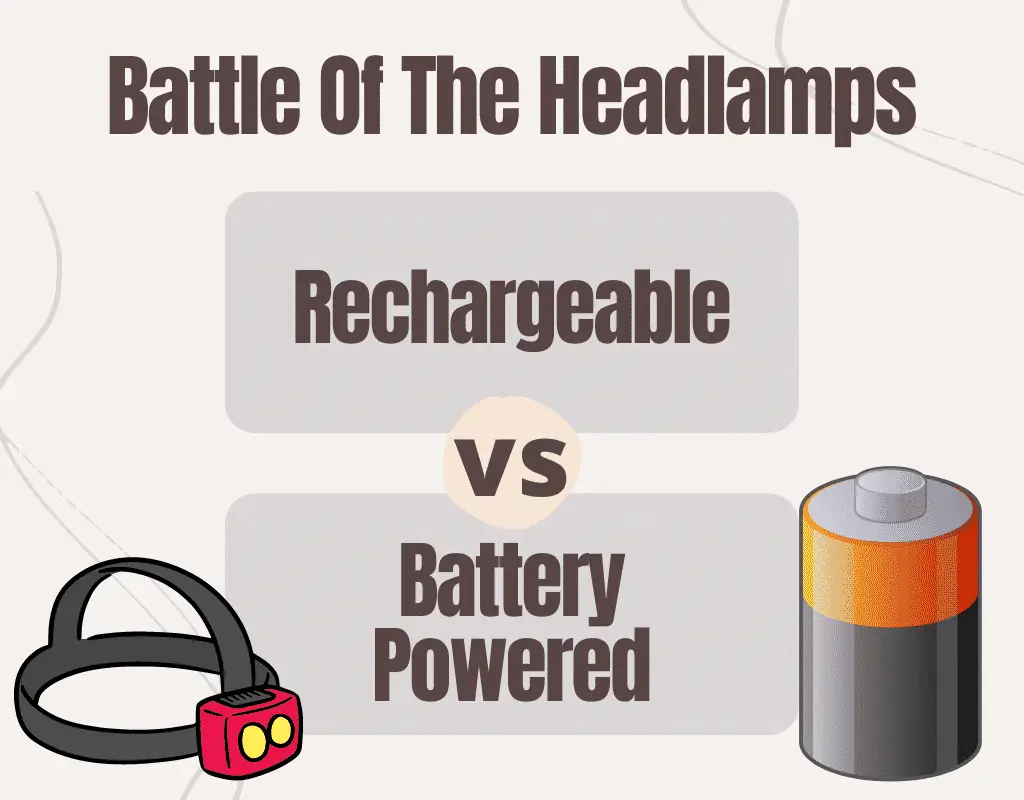Choosing between a battery powered and rechargeable headlamp seems like a tough choice, but it doesn’t have to be! When I first started thinking about replacing my old battery powered headlamp my biggest fear was that I’d be out on a night time hike and the battery would suddenly die. Once I started seeing longer average runtimes with battery powered headlamps it made me question my decision even more. What are the differences between rechargeable headlamps and battery powered headlamps?
Rechargeable Headlamps VS Battery Powered Headlamps: Rechargeable headlamps are more expensive than battery powered headlamps, but it’s worth it! Consistent brightness levels over the entire charge, higher lumen ratings, more versatility at a lighter pack weight, and you don’t have to deal with batteries (and more). There’s no advantage to battery powered headlamps once you factor in battery cost and realize that you can use disposable AAA batteries in most rechargeable headlamps.
There are a few downsides to rechargeable headlamps that I’ll get into later, but most of them have an easy solution to the problem. In the rest of this post I’ll go over all of the advantages and disadvantages of rechargeable headlamps vs batteries and give you solutions to each of the problems.
Rechargeable Headlamps vs Battery Headlamps (aka Non-Rechargeable Headlamp)
Let’s start off by addressing the biggest concern most people have about rechargeable headlamps. Most people worry about not being able to swap out batteries if their headlamp dies on the trail. That’s a common misconception, but it’s completely wrong!
You can almost always use standard disposable AAA batteries (sometimes AA) with rechargeable headlamps (500 lumens or less). Higher lumen headlamps require larger specialized batteries so they can’t be swapped, but the increased battery size extends the runtime. I’ll explain more about this below, but let’s get into what this post is actually about.
Let’s start by going over the advantages and disadvantages of rechargeable headlamps vs non rechargeable headlamps. I’ll give a brief overview in this section, but continue below for a detailed explanation.
Are Rechargeable Headlamps Better Than Battery Powered? Rechargeable Headlamp Benefits and Issues

If you can afford the extra $20-$30 buying a rechargeable headlamp is worth it! There’s really no downside since you can use disposable batteries with most headlamps that are under 500 lumens. Plus, you’ll end up saving money in the long run by not needing to purchase batteries.
Not having to buy batteries all the time is by far the biggest selling point, but there are lots of other reasons why it’s better to purchase a rechargeable headlamp. The runtime won’t be quite as long, but the consistent brightness levels across the entire charge more than make up for that.
Batteries usually last more than 3-4 hours on the maximum brightness setting and 7+ hours on the mid range. That’s more than enough time for the typical person and most people don’t use the max brightness setting for more than a few minutes at a time.
Do you really need to see the entire length of a football field for 4 hours straight? I highly doubt it! Turn down the brightness down to the middle setting and only use it on high when you actually need the extra beam distance. That should get you through an entire night and you’ll have plenty of time to charge the headlamp when the sun comes up.
There are a few disadvantages, but most of them have an easy fix to the problems. The only problem that can’t be solved is that it can be hard/expensive to find batteries for discontinued high lumen headlamps that don’t use standard rechargeable AAA/AA batteries. I mentioned a few of the advantages and disadvantages of using a rechargeable headlamp, but let’s take a detailed look.
| Rechargeable Headlamp Advantages | Rechargeable Headlamp Disadvantages |
|---|---|
| Don’t have to deal with disposable batteries. This saves a lot of money over time and reduces pack weight. You may need to carry a portable power bank on long trips, but most people carry them for their phone anyway. | More expensive upfront, but you don’t have to pay for batteries. You will eventually save money, but it may take a few years. |
| Rechargeable headlamps can have higher lumen ratings with high capacity batteries. This isn’t possible if you want to use disposable batteries, but the longer beam distance may be worth it for specialized jobs. | Battery level drops if you don’t use the headlamp within 2-3 months of charging it. Make sure you charge the battery if it’s been sitting in storage. |
| Much longer runtimes when using a high lumen headlamp on low/medium settings. You can get the same brightness level as the brightest powered headlamp with twice the battery life on lower brightness settings. | Rechargeable headlamps have shorter total runtimes, but they maintain brightness levels longer. Battery powered headlamps gradually dim as they lose power until they’re unusable. They have a longer battery life, but less usable hours. |
| Use a rechargeable headlamp on longer camping trips without spending extra money on batteries. Recharge the batteries with a high capacity power bank on long trips. | Rechargeable batteries last 4-7 years and you can’t always buy replacement batteries. This isn’t a problem with low lumen headlamps (under 500 lumens), but it can be hard to find replacement batteries for discontinued headlamps that use specialized batteries. |
| You can use rechargeable or disposable AAA batteries with most low-moderate lumen rechargeable headlamps. | |
| There’s a battery indicator to tell you how much charge is left in the battery. | |
| Save space and weight in your pack by not having to carry extra batteries on long camping trips. You do have to carry a portable power bank, but most people bring one for there phone anyway. | |
| Easy to charge the headlamp using a USB cable and fast 2-3 hour charge times. You can get 10+ full charge cycles out of a high capacity power bank or 30+ top offs with typical 2-3 hour usage on medium/low brightness settings. | |
| Save money by not having to purchase batteries. Battery powered headlamps are useless once the battery drains below the 30-40% mark. So you throw away batteries that are still at half capacity. Step down modes prevent this issue with rechargeable headlamps. | |
| Rechargeable batteries have a longer useable battery life. Battery powered headlamps gradually dim until they’re completely unusable. Rechargeable headlamps solve this issue by using step down modes so you can use the headlamp until the batteries completely drained. | |
| Rechargeable headlamps have power management modes to provide consistent brightness levels over the entire runtime. They still dim as the battery level drains, but step down modes get you closer to the maximum lumen rating throughout the battery cycle. | |
| Lithium rechargeable batteries are much better in freezing temperatures. Disposable batteries have issues below 32°F, but lithium maintains most of its performance down to about -40°F. Most rechargeable headlamps use lithium batteries, but some use NIMH batteries. |
Battery Powered Headlamp Benefits And Disadvantages

As I mentioned above there’s really no good reason to choose a battery powered headlamp over a rechargeable model. You can use disposable batteries in rechargeable headlamps so that doesn’t matter and there’s only a $20-$30 price difference, but that goes away after adding battery cost.
If you already own a battery powered headlamp you may want to save your money and buy rechargeable AAA batteries so you’re not buying disposables. You can even buy a portable AAA battery charger that you use with a portable power bank or micro USB charger. It won’t be exactly the same as a rechargeable headlamp, but you’d be saving $40-$50.
The only real advantage to battery powered headlamps is the slightly longer battery life. There’s no step down mode to control the brightness so the battery never seems like it’s dimming. That’s great for maintaining brightness over the batteries lifespan, but it does decrease the battery life by 10%-15%.
Step down modes work by decreasing the brightness at predetermined charge levels instead of letting the battery dim as the charge drops (like battery powered headlamps). It increases the lumen output so the light always appears bright, but increasing the lumens reduces the battery life. The battery can be down to 10% charge and it will still perform at about half the advertised lumens depending on the brightness setting.
Battery powered headlamps will last longer, but it may actually seem like your batteries are dying faster. Battery powered flashlights gradually dim as the charge drops. The charge may last longer, but you never get to use all of the lumen rating and it gradually gets to the point where the lights still running but basically useless.
| Battery Powered Headlamp Advantages | Battery Powered Headlamp Disadvantages |
|---|---|
| Battery powered headlamps will be $20-$30 cheaper to buy upfront, but batteries can be expensive over the lifespan of the headlamp. | The cost of constantly buying disposable batteries will add up fast. You can save money by purchasing a USB powered rechargeable battery charger. It runs off a micro USB cord so you can use it with a portable powerbank or phone charger. |
| Disposable batteries have a 7-10 year shelf life so they won’t drain while the headlamps in storage. Rechargeable headlamp batteries drain in 2-3 months if you’re not using them. | Battery powered headlamps don’t have a power management mode to provide consistent brightness levels. As the battery level drops the brightness will gradually dim. So you never get to experience the total lumen rating outside of the first 30 minutes. |
| Longer total runtimes, but the headlamp will gradually dim as the battery drains instead of using step down brightness modes. You won’t get consistent brightness levels, but you should be able to get an extra hour of light at 60 lumens which is enough to work around camp. | Limited to lower lumen headlamps or bulky external battery packs, which aren’t found on quality headlamps. You need 60 lumens inside a dark house/tent, 150 lumens to hike at night, and 350 lumens to spotlight objects at a distance. This can lead to issues as the battery level drops, but you should be fine in 99% of cases. |
| You can find AAA batteries anywhere so you don’t have to worry about finding replacement batteries. It can be hard to find replacement batteries for rechargeable headlamps that use specialized batteries once they’re discontinued. | Runtimes are limited by the voltage of disposable batteries. You get longer runtimes compared to similar lumen headlamps, but don’t expect more than 8 hours with moderate brightness settings. High lumen headlamps use larger batteries so you get longer runtimes on middle/low settings at similar lumen ratings to battery powered headlamps. |
| Don’t worry about finding 2-3 hours to charge your batteries on long camping trips. Just pull out the dead batteries and replace them with new ones. The entire process takes less than 30 seconds to swap in a fresh set of batteries. | You have to carry lots of batteries on longer camping/backpacking trips. Plan on replacing the batteries twice every 3 days depending on how you use the headlamp. You may need to replace them everyday or less frequently if you’re only using the headlamp 1-2 hours per night. |
| Most people carry a portable power bank for their phone on long camping trips, but you can save some money by going with a lower capacity battery. Charging a dead headlamp (under 500 lumens) uses 1,250 mAh of battery charge so you can eat up the charge in a low capacity power bank fast. | There’s rarely a battery indicator on battery powered headlamps. It’s basically a guessing game trying to figure out how much charge is left on your batteries. The bulb dims as the batteries drain. There’s a certain point where it’s hard to see, but you don’t want to throw the batteries away early. So you fumble around with a headlamp that’s not providing enough light. |
| A single AAA battery weighs just over .4 oz. That doesn’t seem like a lot, but you have to carry lots of batteries on long camping trips. I’ve carried just under Plan on carrying 1/2 pound bag of batteries on a week long camping trip. | |
| You always end up throwing away your batteries before they’re completely drained. I never know how much juice is left in my batteries so I end up replacing them every time I use the headlamp. Sometimes they’re almost dead, but I’ve throw away a lot of batteries over the years that are still at 1/2 capacity or more. | |
| There’s no set standard discharge curve that every battery follows. That can make it hard to judge how long of a charge is left in the battery. One brand | |
| Battery powered flashlights have difficulties in cold weather. It’s not a huge issue until you get down into freezing temperatures, but it will speed up the drain on your battery. You can find fix this issue with disposable lithium batteries, but they’re more than twice the price so it’s not worth it. |
Most Rechargeable Headlamps Can Use Disposable AAA Batteries

Most people are under the misconception that you can’t use disposable batteries with rechargeable headlamps. That’s completely wrong in 99% of situations! You can almost always use disposable batteries in rechargeable headlamps that are less than 500 lumens.
That happens to be the maximum lumen rating of battery powered headlamps. Any battery powered headlamp that claims to have more than 500 lumens is either lying about the rating or using a ridiculously large external battery pack (probably both).
Battery powered headlamps are limited by the battery voltage so it’s impossible to increase the lumen rating without increasing the size of the headlamp. Higher lumen rating headlamps (more than 500 lumens) use specialized batteries with more battery capacity.
So you won’t be able to use disposable batteries, but you would never be able to reach those lumen ratings with disposable batteries. It’s like comparing 2 completely different product categories! There’s standard 250-500 lumen headlamps (rechargeable vs battery powered), and specialized high lumen headlamps with longer beam distances that always use rechargeable batteries.
With high lumen headlamps, you won’t get more than 3-4 hours on the maximum brightness setting, but do you really need to see 100+ meters for 4 hours straight? The average person turns their headlamp up to the maximum brightness for a few minutes to spotlight something at a distance and turns the brightness down to reasonable levels. With the oversized battery you can expect 8+ hours on medium (300+ lumens), 12-20 hours on low (150-200 lumens), and 40+ hours on economy modes (60ish lumens).
Best Headlamps That Can Use Both Rechargeable and Disposable Batteries
Most of the rechargeable Petzle Headlamps allow you to use standard rechargeable/disposable AAA batteries. They all have USB charge ports and battery level indicators. The Petzl Actik Core 450 Lumen, Tikka Core 300 Lumen, and Tactikka Core 450 Lumen headlamps all use 3 standard or rechargeable AAA batteries. There are a few other random options from other brands like the Ledlenser MH5 400 lumen (1x AA batteries), Black Diamond ReVolt 350 Lumen (3x AAA batteries), and many more.
Just make sure you check to see which batteries are included since some of the cheaper options don’t have the rechargeable battery (extra $15-$20). It might seem like you’re saving money, but it ends up costing more in the long run.
You Can Always Carry Extra Batteries To Use With A Rechargeable Headlamp
Get the best of both worlds by choosing a rechargeable headlamp that uses AAA rechargeable batteries. Carry a few extra batteries in your pocket so you can swap them into the headlamp if they die on the trail. They have a USB charging port so you can easily recharge the batteries on the trail, and there’s no need for specialized replacement batteries.
Some headlamps don’t have a way to replace the batteries and it can be hard to find replacements if you can swap them out. Manufacturers change the battery style every couple of years so you have to buy a replacement battery when you get the headlamp or get a new headlamp since you can’t find a battery.
This issue can be completely avoided with a headlamp that uses standard rechargeable AAAs. The headlamp may weigh a fraction of an oz more, but the added convenience more than makes up for that problem. You can even use normal disposable AAAs in most of them unless they specifically say not to.
The only downside is you’re limited to about 500 lumens which is more than enough for most tasks. It only takes 25-50 lumens to light up a room/tent, 100-150 lumens to hike through the woods, and 350-500 lumens to spotlight objects at 70-100 meters. You would only need a higher lumen headlamp if you’re using it for search and rescue jobs or need to spotlight animals at a ridiculously long distance.




